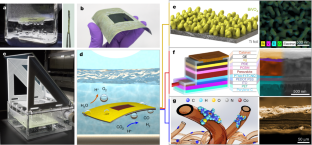研究者らは、太陽光と水からクリーンな燃料を生成する浮体式「人工葉」を開発し、将来的には海上で大規模な運用が可能になると考えています。 Researchers have developed floating ‘artificial leaves’ that generate clean fuels from sunlight and water, and could eventually operate on a large scale at sea.
2022-08-17 ケンブリッジ大学
川で軽量この「人工葉」を使った屋外試験を行い、植物の葉と同様に太陽光を効率よく燃料に変換できることを確認した。
この人工葉の規模を拡大すれば、汚染された水路や港湾、海上でも使用でき、化石燃料に依存する世界の海運業界の削減に貢献する可能性がある。
研究チームは、柔軟なプラスチックや金属箔に塗布できる薄膜金属酸化物やペロブスカイトと呼ばれる材料を使用した。さらに、このデバイスを撥水性のある炭素ベースの薄膜で覆い、水分の劣化を防いだ。その結果、動作するだけでなく、本物の葉のように見えるデバイスが完成した。
新しい人工葉のテストでは、水を水素と酸素に分解したり、CO2を合成ガスに還元したりできることがわかった。
<関連情報>
- https://www.cam.ac.uk/stories/floating-artificial-leaves
- https://www.nature.com/articles/s41586-022-04978-6
スケーラブルな太陽電池燃料製造のための浮遊型ペロブスカイト-BiVO4デバイス Floating perovskite-BiVO4 devices for scalable solar fuel production
Virgil Andrei,Geani M. Ucoski,Chanon Pornrungroj,Chawit Uswachoke,Qian Wang,Demetra S. Achilleos,Hatice Kasap,Katarzyna P. Sokol,Robert A. Jagt,Haijiao Lu,Takashi Lawson,Andreas Wagner,Sebastian D. Pike,Dominic S. Wright,Robert L. Z. Hoye,Judith L. MacManus-Driscoll,Hannah J. Joyce,Richard H. Friend & Erwin Reisner
Nature Published:17 August 2022
DOI:https://doi.org/10.1038/s41586-022-04978-6

Abstract
Photoelectrochemical (PEC) artificial leaves hold the potential to lower the costs of sustainable solar fuel production by integrating light harvesting and catalysis within one compact device. However, current deposition techniques limit their scalability1, whereas fragile and heavy bulk materials can affect their transport and deployment. Here we demonstrate the fabrication of lightweight artificial leaves by employing thin, flexible substrates and carbonaceous protection layers. Lead halide perovskite photocathodes deposited onto indium tin oxide-coated polyethylene terephthalate achieved an activity of 4,266 µmol H2 g−1 h−1 using a platinum catalyst, whereas photocathodes with a molecular Co catalyst for CO2 reduction attained a high CO:H2 selectivity of 7.2 under lower (0.1 sun) irradiation. The corresponding lightweight perovskite-BiVO4 PEC devices showed unassisted solar-to-fuel efficiencies of 0.58% (H2) and 0.053% (CO), respectively. Their potential for scalability is demonstrated by 100 cm2 stand-alone artificial leaves, which sustained a comparable performance and stability (of approximately 24 h) to their 1.7 cm2 counterparts. Bubbles formed under operation further enabled 30–100 mg cm−2 devices to float, while lightweight reactors facilitated gas collection during outdoor testing on a river. This leaf-like PEC device bridges the gulf in weight between traditional solar fuel approaches, showcasing activities per gram comparable to those of photocatalytic suspensions and plant leaves. The presented lightweight, floating systems may enable open-water applications, thus avoiding competition with land use.



